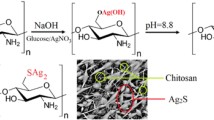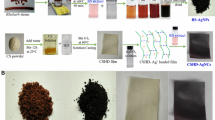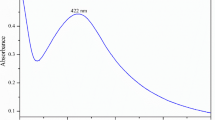Abstract
In the present study, silver, cadmium, iron and copper nanoparticles were biosynthesized by Salmonella typhimurium, Staphylococcus aureus, Candida albicans and Fusarium avenaceum strains. Analysis of the synthesized nanoparticles using the dynamic light scattering (DLS) revealed that the smallest nanoparticles were obtained by Salmonella typhimurium. The formation of the synthesized bio-AgNPs was confirmed by UV–Vis spectroscopy. The Ag, Cd, Fe and Cu nanoparticles produced by Salmonella typhimurium were separately immobilized on the chitosan (CS) framework by the impregnation method. The prepared CS-bio-nanocomposites were characterized by X-ray diffraction (XRD). The prepared compounds were investigated against three cancer cells (MCF-7, HeLa and HCT-1l6) for anticancer activity as well as against different microbial strains as antimicrobial activity. CS-bioAgNP composite clearly showed the greatest cytotoxicity against different cancer cell lines. Also, the CS-bioAgNP composite resulted in the highest inhibitory effect against different microbial growth strains using disk diffusion and kill time methods when compared with chitosan and other CS-bioNPs composites. Therefore, the present study provides evidence of novel antimicrobial and potent cytotoxicity characteristics of CS-bio-nanocomposite material that can be effectively utilized in the medical field.









Similar content being viewed by others
References
Al-Ostoot FH, Vidya R, Mohammed YH, Jyothi M, Pallavi H, Khanum SA (2018) Statistical analysis of antimicrobial data of 2-[2-(Aroyl) aroyloxy] methyl-1, 3, 4 oxadiazoles analogues using ANOVA. Asian J Pharm 11:293–297
Asha-Rani PV, Mun GLK, Hande MP, Valiyaveettil S (2009) Cytotoxicity and genotoxicity of silver nanoparticles in human cells. ACS Nano 3:279–290
Avinash PI, Nelson D, Mahendra R (2014) Bioactivity, mechanism of action and cytotoxicity of copper-based nanoparticles: A review. Appl Microbiol Biotechnol 98:1001–1009
Badr EA, Shafek SH, Hefni HHH, Elsharif AM, Alanezi AA, Shaban SM, Kim DH (2021) Synthesis of Schiff base-based cationic Gemini surfactants and evaluation of their effect on in-situ AgNPs preparation: Structure, catalytic and biological activity study. J Molecr Liquids 326:115342
Balouiri M, Sadiki M, Ibnsouda SK (2016) Methods for in vitro evaluating antimicrobial activity: A review. J Pharm Anal. 4:71–79
Barry AL, Craig WA, Nadler H, Reller LB, Sanders CC, Swenson JM (1999) Methods for determining bactericidal activity of antimicrobial agents; approved guideline. NCCLS document M26-A. National Committee for Clinical Laboratory Standards, Wayne, PA
Bastos EM, Simone M, Jorge DM, Soares AE, Spivak MJ (2008) In vitro study of the antimicrobial activity of Brazilian propolis against Paenibacillus larvae. J Invert Pathol 97:273–281
Bong-Kyu C, Kwang-Yoon K, Yun-Jung Y, Suk-Jung O, Jong-Hoon C (2001) Chong-Youl Kim (2001) Int. J Antimicrob Agents 18:553–557
Cao XL, Cheng C, Ma YL, Zhao CS (2010) Preparation of silver nanoparticles with antimicrobial activities and the researches of their biocompatibilities. J Mat Sci: Mat Med 21:2861–2868
Chung YC, Su YP, Chen CC, Jia G, Wang HI, Wu JC, Lin JY (2004) Relationship between antibacterial activity of chitosan and surface characteristics of cell wall. Acta Pharm Sinica 25:932–936
Dakal TC, Kumar A, Majumdar RS, Yadav V (2016) Mechanistic basis of antimicrobial actions of silver nanoparticles. Front Microb. https://doi.org/10.3389/fmicb.2016.01831
Dutta PK, Rinki K, Dutta J (2011) Chitosan: a promising biomaterial for tissue engineering scaffolds. In: Chitosan for biomaterials II. Springer, pp 45–79
Ghorbani HR (2013) Biosynthesis of silver nanoparticles using Salmonella typhirium. J Nanostr Chem 3:29–32
Gu H, Ho PL, Tong E, Wang L, Xu B (2003) Presenting vancomycin on nanoparticles to enhance antimicrobial activities. Nano Lett 3:1261–1263
Hussein MHM, El-Hady MF, Sayed WM, Hefni H (2012) Preparation of some chitosan heavy metal complexes and study of its properties. Poly Sci Ser A 54(2):113–124
Jbeli A, Hamden Z, Bouattour S, Ferraria AM, ConceiÃão DS, Ferreira LF, Chehimi MM, do- Rego MB, Vilar MR, Boufi S, (2018) Chitosan-Ag-TiO2 films: An effective photocatalyst under visible light. Carbohy Poly 199:31–40
Jin Y, Zhao X (2009) Cytotoxicity of photoactive nanoparticles. In: safety of nanoparticles. Springer, New York, pp 19–31. https://doi.org/10.1007/978-0-387-78608-7
Kathiresan K, Manivannan S, Nabeel MA, Dhivya B (2009) Studies on silver nanoparticles synthesized by a marine fungus, Penicillium fellutanum isolated from coastal mangrove sediment. Coll Surf b: Biointer 71:133–137
Kaur P, Choudhary A, Thakur R (2013) Synthesis of chitosan-silver nanocomposites and their antibacterial activity. Intern J Sci Engine Res 4(4):869–872
Kaur A, Preet S, Kumar V, Kumar R, Kumar R (2019) Synergetic effect of vancomycin loaded silver nanoparticles for enhanced antibacterial activity. Coll Surf B: Biointer 176:62–69
Khan I, Saeed K, Khan I (2019) Review Nanoparticles: properties, applications and toxicities. Arab J Chem 12:908–931
Kim KJ, Sung WS, Suh BK, Moon SK, Choi JS, Kim JG, Lee DG (2009) Antifungal activity and mode of action of silver nano-particles on Candida albicans. Biom: J Role Met Ions Biol Biochem Med 22:235–242
Konaté K, Mavoungou JF, Lepengué AN, Aworet-Samseny RR, Hilou A, Souza A, Dicko MH, M’batchi B, (2012) Antibacterial activity against β-lactamase producing Methicillin and Ampicillin-resistants’ Staphylococcus aureus: Fractional Inhibitory Concentration Index (FICI) determination. Ann Clini Microbiol Antimicro 11:1–29
Kong L, Gao Y, Cao W, Gong Y, Zhao N, Zhang X (2005) Preparation and characterization of nanohydroxyapatite/chitosan composite scaffolds. J Biom Mat Res Part a: Offi J Soci Bioma Jap Soc Bioma Aust Soc Bioma Kor Soc Bioma 75:275–282
Kumar R, Sharma P, Bamal A, Sushma Negi S, Chaudhary S (2017) A safe, efficient and environment friendly biosynthesis of silver nanoparticles using Leucaena leucocephala seed extract and its antioxidant, antimicrobial, antifungal activities and potential in sensing. Green Process Synth 6:449–459
L’Azou B, Passagne I, Mounicou S, Tréguer-Delapierre M, Puljalté I, Szpunar J, Ohayon-Courtès C (2014) Comparative cytotoxicity of cadmium forms (CdCl2, CdO, CdS micro-and nanoparticles) in renal cells. Toxicol Res 3(1):32–41
Li J, Tang X, Yi H, Yu Q, Gao F, Zhang R, Li C, Chu C (2017) Effects of copper-precursors on the catalytic activity of Cu/graphene catalysts for the selective catalytic oxidation of ammonia. Appl Surf Sci 412:37–44
Li-Feng Q, Zi-Rong X, Yan L, Xia J, Xin-Yan H (2005) In-vitro effects of chitosan nanoparticles on proliferation of human gastric carcinoma cell line MGC803 cells. World J Gastroentero 11(33):5136–5514
Liu Y, Babu HV, Zhao J, GoÃi-Urtiaga A, Sainz R, Ferritto R, Pita M, Wang DY (2016) Effect of Cu-doped graphene on the flammability and thermal properties of epoxy composites. Comp Part b: Engin 89:108–116
Mandal D, Bolander ME, Mukhopadhyay D, Sarkar G (2006) The use of microorganism for the formation of metal nanoparticles and their application. Appl Microbiol Biotechnol 69(5):485–492
Mlalila NG, Swai HS, Hilonga A, Kadam DM (2017) Antimicrobial dependence of silver nanoparticles on surface plasmon resonance bands against Escherichia coli. Nanotechnol Sci Applic 10:1–9
Mohsena E, El-Borady OM, Mohamed MB, Fahim IS (2020) Synthesis and characterization of ciprofloxacin loaded silver nanoparticles and investigation of their antibacterial effect. J Radi Res Appl Sci 13(1):416–425. https://doi.org/10.1080/16878507.2020.1748941
Motawie AM, Mahmoud KF, El-Sawy AA, Kamal HM, Hefni H, Ibrahiem HA (2014) Preparation of chitosan from the shrimp shells and its application for pre-concentration of uranium after cross-linking with epichlorohydrin. Egy J Petro 23:221–228
Mott D, Galkowski J, Wang L, Luo J, Zhong CJ (2007) Synthesis of size-controlled and shaped copper nanoparticles. Langmuir 23:5740–5745
Mukherjee PS, Das AK, Dutta B, Meikap AK (2017) Role of silver nanotube on conductivity, dielectric permittivity and current voltage characteristics of polyvinyl alcohol-silver nanocomposite film. J Phys Chem Sol 111:266–273
Muzzarelli RA, Tarsi R, Filippini O, Giovanetti E, Biagini G, Varaldo P (1990) Antimicro Agents Chemother 34:2019–2033
Ovais M, Khalil AT, Ayaz M, Ahmad I, Nethi SK, Mukherjee S (2018) Review: Biosynthesis of metal nanoparticles via microbial enzymes: A mechanistic approach. Intern J Mole Sci 19(12):4100–4120
Pérez-Herrero E, Fernández-Medarde A (2015) Advanced targeted therapies in cancer: drug nanocarriers, the future of chemotherapy. Euro J Pharm Biopharm 93:52–79
Pujalté I, Passagne I, Brouillaud B, Tréguer M, Durand E, Ohayon-Courtès C, L’Azou B (2011) Cytotoxicity and oxidative stress induced by different metallic nanoparticles on human kidney cells. Part Fiber Toxicol 8(1):10–17
Raffi M, Hussain F, Bhatti TM, Akhter JI, Hameed A, Hasan MM (2008) Antibacterial characterization of silver nanoparticles against E. coli ATCC-15224. J Mat Sci Technol 24:192–196
Roller S, Covill N (1999) The antifungal properties of chitosan in laboratory media and apple juice. Int J Food Microbiol 73:672–681
Satyavani K, Gurudeeban S, Ramanathan T, Balasubramanian T (2011) Biomedical potential of silver nanoparticles synthesized from calli cells of Citrullus colocynthis (L) Schrad. J Nanobiotechnol. 9(43):2–8
Schrand AM, Rahman MF, Hussain SM, Schlager JJ, Smith DA, Syed AF (2010) Metal-based nanoparticles and their toxicity assessment. Wires Nanomed Nanobiotechnol 2(5):544–568
Shahverdi AR, Fakhimi A, Shahverdi HR, Minaian S (2007) Synthesis and effect of silver nanoparticles on the antibacterial activity of different antibiotics against Staphylococcus aureus and Escherichia coli. Nanomed Nanotechnol Biol Med 3(2):168–171
Sriram MI, Kanth SB, Kalishwaralal K, Gurunathan S (2010) Antitumor activity of silver nanoparticles in Dalton’s lymphoma ascites tumor model. Intern J Nanomed 5:753–762
SuÃrez-Cerda J, Espinoza-GÃmez H, Alonso-NÃÃez G, Rivero IA, Gochi-Ponce Y, Flores-LÃpez LA (2017) A green synthesis of copper nanoparticles using native cyclodextrins as stabilizing agents. J Saudi Chem Soc 21:341–348
Sunkar S, Nachiyar CV (2012) Biogenesis of antibacterial silver nanoparticles using the endophytic bacterium Bacillus cereus isolated from Garcinia xanthochymus. Asi Paci J Trop Biomedi 2(12):953–959
Thomas V, Yallapu MM, Sreedhar B, Bajpai SK (2009) Fabrication, characterization of chitosan/nanosilver film and its potential antibacterial application. J Biomt Sci Poly Edit 20:2129–2144
Torres SK, Campos VL, Leà CG, RodrÃguez-Llamazares SM, Rojas SM, Gonzalez M, Smith C, Mondaca MA, (2012) Biosynthesis of selenium nanoparticles by Pantoea agglomerans and their antioxidant activity. J Nanopar Res 14(11):1236–1245. https://doi.org/10.1007/s11051-012-1236-3
Usman MS, Ibrahim NA, Shameli K, Zainuddin N, Yunus WM (2012) Copper nanoparticles mediated by chitosan: synthesis and characterization via chemical methods. Mole 7(12):14928–14936
Vasileva P, Donkova B, Karadjova I, Dushkin C (2011) Synthesis of starch-stabilized silver nanoparticles and their application as a surface plasmon resonance-based sensor of hydrogen peroxide. Coll Surf a: Physic Engin Asp 382:203–210
Wang X, Du Y, Li H (2004) Preparation, characterization and antimicrobial activity of chitosan Zn complex. Carbohy Poly 56:21–26
Wei D, Sun W, Qian W, Ye Y, Ma X (2009) The Synthesis of Chitosan-Based Silver Nanoparticles and Their Antibacterial Activity Carbohydrate Research 344:2375–2382
Xia T, Kovochich M, Brant J, Hotze M, Sempf J, Oberley T, Sioutas C, Yeh J, Wiesner M, Nel A (2006) Comparison of the abilities of ambient and manufactured nanoparticles to induce cellular toxicity according to an oxidative stress paradigm. Nano Lett 6:1794–1807
Yasmin S, Nouren S, Bhatti HN, Iqbal DN, Iftikhar S, Majeed J, Mustafa R, Nisar N, Nisar J, Arif Nazir A, Iqbal M, Rizvi H (2020) Green synthesis, characterization and photocatalytic applications of silver nanoparticles using Diospyros lotus. Gre Proces Synth 9:87–96
Yuvakkumar R, Elango V, Rajendran V, Kannan N (2011) Preparation and characterization of zero valent iron nanoparticles. Dig J Nanomat Biostruc 6:1771–1776
Author information
Authors and Affiliations
Contributions
H.S. El-Sheshtawy and M.F. Mady performed the biosynthesis of different nanoparticles by different microbial strains. The two authors also investigated the antimicrobial activity of the prepared CS-bio-nanocomposites against different microbial strains. H.H.H. Hefni performed the preparation of chitosan bio-nanocomposites. Wael A. Aboutaleb achieved the characterization of the prepared CS-bio-nanocomposites. M.M. Elaasser performed the cytotoxicity of the prepared CS-bio-nanocomposites against the tumor cells. All the authors contributed to the interpretation of the data in the manuscript and writing the manuscript. All authors read and approved the final manuscript. H.H. El-Shiekh performed the final revision of the manuscript.
Corresponding author
Ethics declarations
Conflict of interest
The authors declare that they have no competing interests.
Consent to Participate
All authors accepted for the participation of this manuscript.
Consent to Publish
All authors accepted for publishing this manuscript.
Rights and permissions
About this article
Cite this article
El-Sheshtawy, H.S., Hefni, H.H.H., Aboutaleb, W.A. et al. Green Synthesis of Chitosan Bio-Nanocomposites and Investigation of their Antimicrobial and Antitumor Effects. Iran J Sci Technol Trans Sci 45, 1247–1261 (2021). https://doi.org/10.1007/s40995-021-01147-8
Received:
Accepted:
Published:
Issue Date:
DOI: https://doi.org/10.1007/s40995-021-01147-8




